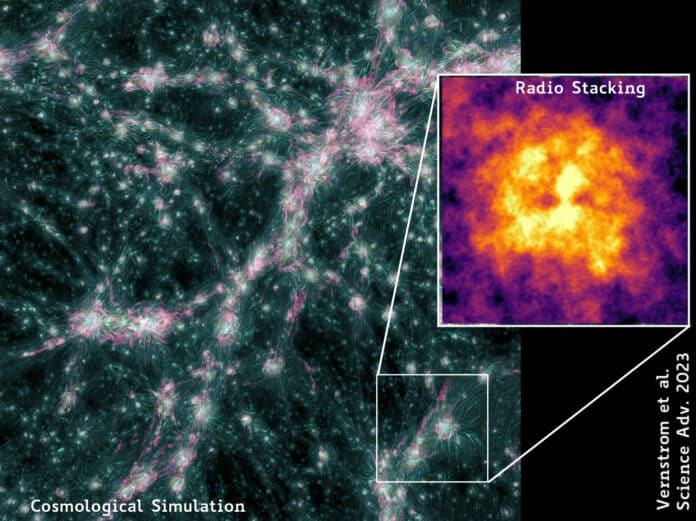The cosmic web is the term used to refer to the clusters, filaments, and voids that make up the large-scale structure of the Universe. In Λ cold dark matter (ΛCDM) cosmology, this web is formed from the anisotropic gravitational collapse of matter from primordial overdensities.
We’ve been able to map the Cosmic Web through observation over the past few decades, which opens up the possibility of finding answers to some of astronomy’s most pressing issues. An area of particular interest is how magnetic fields behave on a cosmic scale and their role in galactic and cosmic structure formation.
ICRAR scientists discover tantalizing evidence of magnetic fields in the universe’s most significant cosmic structures.
Dr. Tessa Vernstrom from The University of Western Australia’s (UWA) node of ICRAR said, “Magnetic fields pervade the universe – from planets and stars to the largest spaces in-between galaxies. However, many aspects of cosmic magnetism are not yet fully understood, especially at the scales seen in the cosmic web.”
“When matter merges in the universe, it produces a shockwave which accelerates particles, amplifying these intergalactic magnetic fields.”
The study recorded radio emissions from the cosmic web – the first observational evidence of strong shockwaves. It was thought that this event, which had only previously been seen in the greatest galaxy clusters in the cosmos, was the’signature’ of matter collisions throughout the cosmic web.
Dr. Vernstrom said, “These shockwaves give off radio emissions which should result in the cosmic web ‘glowing’ in the radio spectrum, but it had never been conclusively detected due to how faint the signals are.”
In 2020, Dr. Vernstrom’s team started looking for the cosmic web’s “radio glow” and discovered signals that might have come from these cosmic waves. Vernstrom chose polarised radio light as a signal type because it has less background “noise” because the initial transmissions may have contained emissions from galaxies and other astronomical objects in addition to the shockwaves.
However, Vernstrom chose a different signal type with less background “noise” — polarised radio light — as these first signals might have contained emissions from galaxies and astronomical objects other than the shockwaves.
Vernstrom said, “As very few sources emit polarised radio light, our search was less prone to contamination, and we have been able to provide much stronger evidence that we are seeing emissions from the shockwaves in the largest structures in the universe, which helps to confirm our models for the growth of this large-scale structure.”
For this study, scientists used data and all-sky radio maps from the Global Magneto-Ionic Medium Survey, the Planck Legacy Archive, the Owens Valley Long Wavelength Array, and the Murchison Widefield Array. The team stacked the data over the known clusters and filaments in the cosmic web.
The stacking method helps to strengthen the faint signal above the image noise, which was then compared to state-of-the-art cosmological simulations generated through the Enzo Project.
These simulations are the first to include predictions of the polarised radio light from the cosmic shockwaves observed as part of this research.
Journal Reference:
- Tessa Vernstrom et al. Polarized accretion shocks from the cosmic web. Science Advances. DOI: 10.1126/sciadv.ade7233
